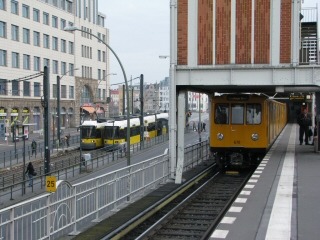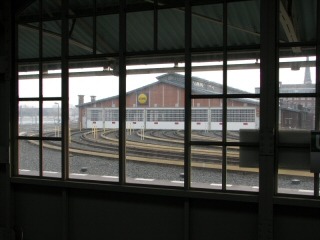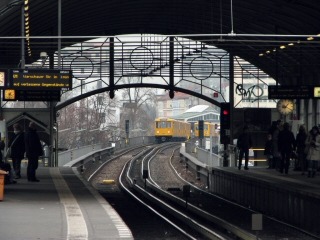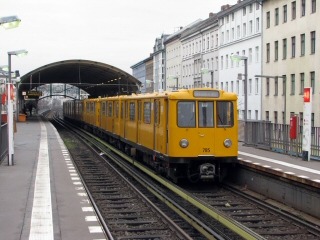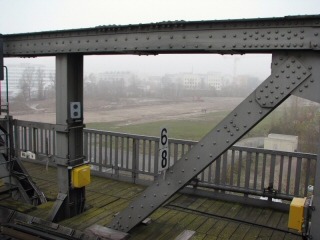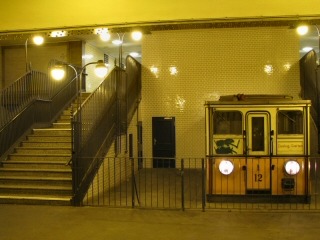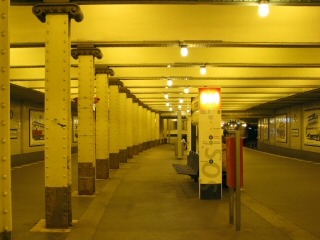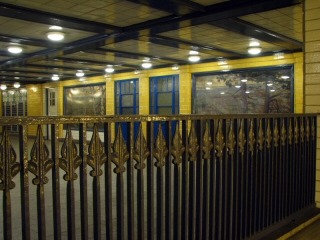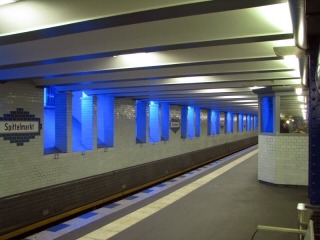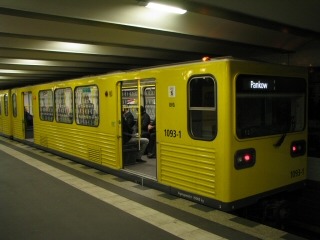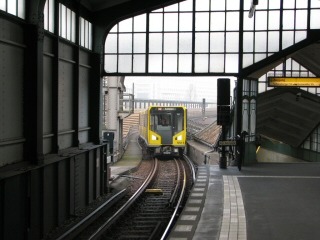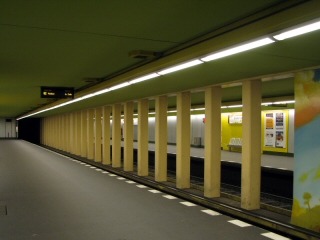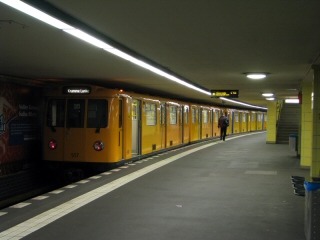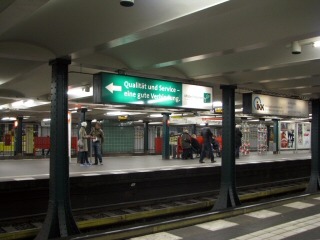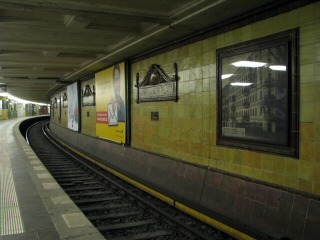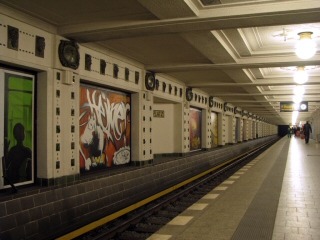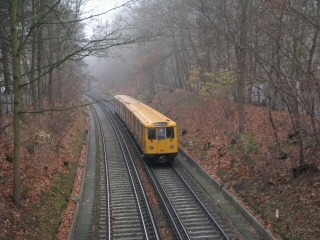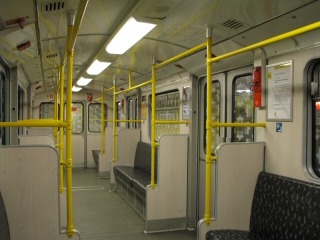budapest
other hungarian
close-up
lost rails
other countries
A bit of Berlin U-Bahn
The U-Bahn (subway, underground railway) of Berlin is not as famous as the New York subway or the Paris métropolitain - in spite of its age and many of its interesting features. I'm still very far from knowing this system well enough, but that won't stop me from showing you a few pictures and videos of it :)
The most striking feature of the Berlin U-Bahn is that there are two kinds of lines: narrow and wide profile ones. The first (lines U1, U2, U3 and U4) use vehicles with a width of 2.3 meters, the latter (U5, U55, U6, U7, U8, U9) feature trains with a width of 2.65 metes.
Interestingly there are also S-Bahn lines running under the city, looking pretty much like a U-Bahn, with compact trains (albeit about 3 meters wide) using third-rail electrification. These three forms of rapid transit are not operationally interconnected, and while the two kinds of U-Bahn lines belong to the municipal transport company BVG, the S-Bahn is operated by a subsidiary of german rail operator Deutsche Bahn.
U1 (Warschauer Strasse - Uhlandstrasse)
The oldest U-Bahn lines were once part of a common backbone system (referred to as the "Stammstrecke"), and U1 is an amalgam of parts of that (built between 1896 and 1902), and later extensions (built between 1907 and 1926). The eastern section was built as an elevated railway, because the city of Berlin had fears about underground operations interrupting its public utility services, while the western parts were built underground, because the then-separate city of Charlottenburg was more worried about its city landsape.
To the left: the eastern terminus Warschauer Strasse. After the erection of the Berlin Wall, this bit belonged to East-Berlin, so the line - situated on/in West-Berlin ground save this terminus - was cut at Schesisches Tor, located on the other side of the river Spree. The line was re-opened in its original length only in 1995. To the right: elevated car-barn for the U-Bahn, right next to the terminus. The ground floor of that building originally housed a tram depot.
Two shots of the typical elevated station Görlitzer Bahnhof. The name of the station refers to a nearby railway station - closed in 1951 - by the same name.
The crossing/tower station Gleisdreieck is built in elevation. The ground beneath/around looks quite deserted: it used to belong to the Potsdamer Bahnhof, another railway station closed after World War 2. Because this area was close to the soviet sector border/the Berlin Wall, the railway's premises remained mostly unused.
A video compilation of the line.
If I was to give epithets to these lines, I would call U1 "industrial jewel " - and U2 would be "architectually and aesthetically prominent". If you ask me, at some stations it looks like Budapest's "kisföldalatti" on a large scale :) The line is a very important backbone of Berlin's public transport network, with a full length of 20 kilometers. Today's U2 was cut in two halves by the Berlin Wall in 1961: the "eastern" line ended at Mohrenstrasse (then called Thälmannplatz), while the "western" half terminated first at Gleisdreieck, and later at Nollendorfplatz. After 1978, the abandoned elevated stretch in West-Berlin featured an old streetcar as a tourist attraction, connecting the flea markets operating in the disused stations.
The central section of this line was built later than today's U1, and it seems municipal authorities befriended underground constructions by then. One of the nicest stations is Klosterstrasse, opened in 1913. The station was renovated in the 1980s by the East-Berlin regime, which wanted to turn the site into a living transportation history exhibition (this lovely idea was fortunately continued after the political turns). The old vehicle to the right was originally used on the U-Bahn line to Schöneberg (today's U4) - I don't know more about it, but it's a nice addition to the posters of old vehicles on the walls!
To the left: if you look carefully at the floor, you will notice an empty area flanked by lighter strips on its sides. Originally this stop was planned to be the start of a branch-line, which was then never built. To the right: it's worth to stroll a bit around the corridors of this subway, there are some beautiful details to be seen!
Spittelmarkt: interesting to know that this station was operated as a terminus between 1908 and 13 for the extension of the "Stammstrecke" coming from Potsdamer Platz. One side of the station is flanked by the Spree river - the blue openings on the wall are gallery windows facing the water (the blue light is of course artifical). To the right: AFAIK this is the only U-Bahn line, where these train-sets of East-german production are still used.
We saw the U1 station Gleisdreieck earlier, now let's go one story deeper, to the U2's station there!
I did not manage to ride the line on its entire length, because I kept on getting off and taking videos, to the point when I had to leave abruptly to catch my plane back to Budapest :)
To the left: the Bismarckstrasse station was built in the 1970s into the middle of the old line, in the minimalist style of the "west". To the right: Deutsche Oper. This station features four tracks, because once this was the start of a short branch-line to Richard-Wagner-Platz (closed in 1970). The branch-line was substituted by the new (wide-profile) U7 line, but parts of the old tunnel are retained as a connection between the lines (not used in passenger traffic because of the differences in loading gauge and third-rail usage).
U3 (Nollendorfplatz - Krumme Lanke)
This line connects the city center to the south-western suburbs of Zehlendorf and Dahlem. It was planned as a branch for the well-off city of Wilmersdorf, but the idea was opposed by Charlottenburg: they saw a competitor in Wilmersdorf, and blocked the construction of the line through their territory (which was needed to reach the "Stammstrecke"). At the end the line was built, and Charlottenburg received a new branch-line in return (the Kurfürstendamm - Uhlandstrasse stretch of today's U1). Interesting to note that six years ago, when I first rode this line, it was called "U1".
In my opinion the U3 is the nicest of the classic U-Bahn lines, but you'll see nothing of that at the Nollendorfplatz terminus, seen to the left. To the right: Wittenbergplatz, featuring 5 tracks used by 3 lines (if I counted correctly).
As I said, Wilmersdorf was a rich town, so they wanted to have noble-looking stations. As a result, the stations between Hohenzollernplatz and Breitenbachplatz are just like small palaces! On the two photos above: Fehrbelliner Platz - one of the more modest stops.
Heidelberger Platz is my favorite one: the tunnel passes under the S-Bahn here, thus this station is located deeper than the others. This gave the architects an opportunity to build an almost cathedral-like vaulted archway with chandeliers, as seen above. I wonder if the richly ornamented stations of the Moscow metro were inspired by this station!
Rüdesheimer Platz is also quite nice - note the graffiti "frescos" in the tabernacles!
The end of the line runs on the surface in a cutting, and the stations are also more modern (and kept simple to save money). It still has some appeal, though - the modern of the 1920s is clearly different to "today's modern"!
To the left: a trainset leaving the stop "Uncle Tom's Cabin" (Onkel Toms Hütte - named after a pub that was named after the novel). To the right: the interior of a train. "Narrow profile" is not just a name: it is narrow :)
Next page: a bit of wide-profile...
Back to the top Back to the main page
